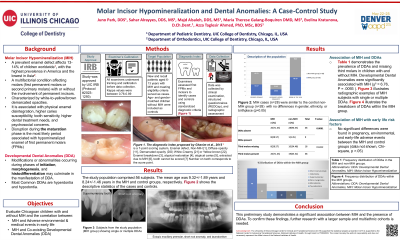Growth & Development
29 - Molar Incisor Hypomineralization and Dental Anomalies: A Case-Control Study


Juno Park, DDS
Pediatric Dental Resident
University of Illinois at Chicago, Chicago IL
University of Illinois at Chicago, Chicago IL
Chicago, Illinois, United States- AT
Azza Tagelsir Ahmed, PhD, MSc, BDS
Clinical Associate Professor
University of Illinois at Chicago, Chicago IL
Chicago, Illinois, United States 
Brittaney J. Hill, DDS, MS, MPH
Clinical Associate Professor and Residency Program Director
University of Illinois Chicago, Chicago IL
University of Illinois at Chicago
Chicago, Illinois, United States
Presenting Author(s)
Research Mentor(s)
Program Director(s)
Purpose: To evaluate the association between Molar Incisor Hypomineralization (MIH), early-life adverse environmental and medical events, and co-existing developmental dental anomalies (DDA).
Methods: This case-control study included children aged 6–13 years, with the presence of MIH serving as the inclusion criterion for the case group. Each child with MIH was matched with a child without MIH of similar age and demographic characteristics to form the control group. Trained and calibrated examiners assessed MIH using standardized diagnostic criteria. Biological mothers completed a structured questionnaire addressing pregnancy and early-life adverse events. DDA were identified through clinical and radiographic assessment. Statistical analyses included descriptive statistics, Chi-square and Fisher’s exact tests, and logistic regression.
Results: A total of 56 children were enrolled, including 28 in the MIH group and 28 in the control group. The mean age was 9.32 ± 1.89 years in the MIH group and 8.24 ± 1.46 years in the control group. Among the MIH group, 89.3% were born in the United States compared to 96.3% in the control group, and 70.4% were Hispanic or Latino compared to 78.6% in the control group. Developmental dental anomalies were significantly associated with MIH (χ² = 6.76, P = .0093). No significant differences were found in pregnancy, environmental, and early-life adverse events between the MIH and control groups (P > .05).
Conclusions: This preliminary study demonstrates a significant association between MIH and the presence of DDA. Further research with larger sample sizes is needed to confirm these findings.
Identify Supporting Agency and Grant Number:

.jpg)